Organizational Structure and Culture in Health and Social Care: Report
VerifiedAdded on 2020/01/07
|18
|5890
|261
Report
AI Summary
This report provides a detailed analysis of health and social care organizations, examining the impact of external environmental factors, organizational structures, and organizational culture. The report explores how organizations respond to external factors, including those from stakeholders, and compares and contrasts different organizational structures, such as functional, divisional, and matrix structures. It also delves into the concept of organizational culture, assessing its impact on service delivery, and evaluates theories related to individual and group behavior. Furthermore, the report assesses leadership concepts, effectiveness, and specific contributions within health and social care organizations, providing a comprehensive overview of the key elements that shape these critical institutions. The study uses the example of Voluntary Service Overseas (VSO) as a case study. The report uses the PESLE analysis (Political, Economic, Sociological, Legislative, and Environmental factors) to determine the effect of the external factors on the organization.
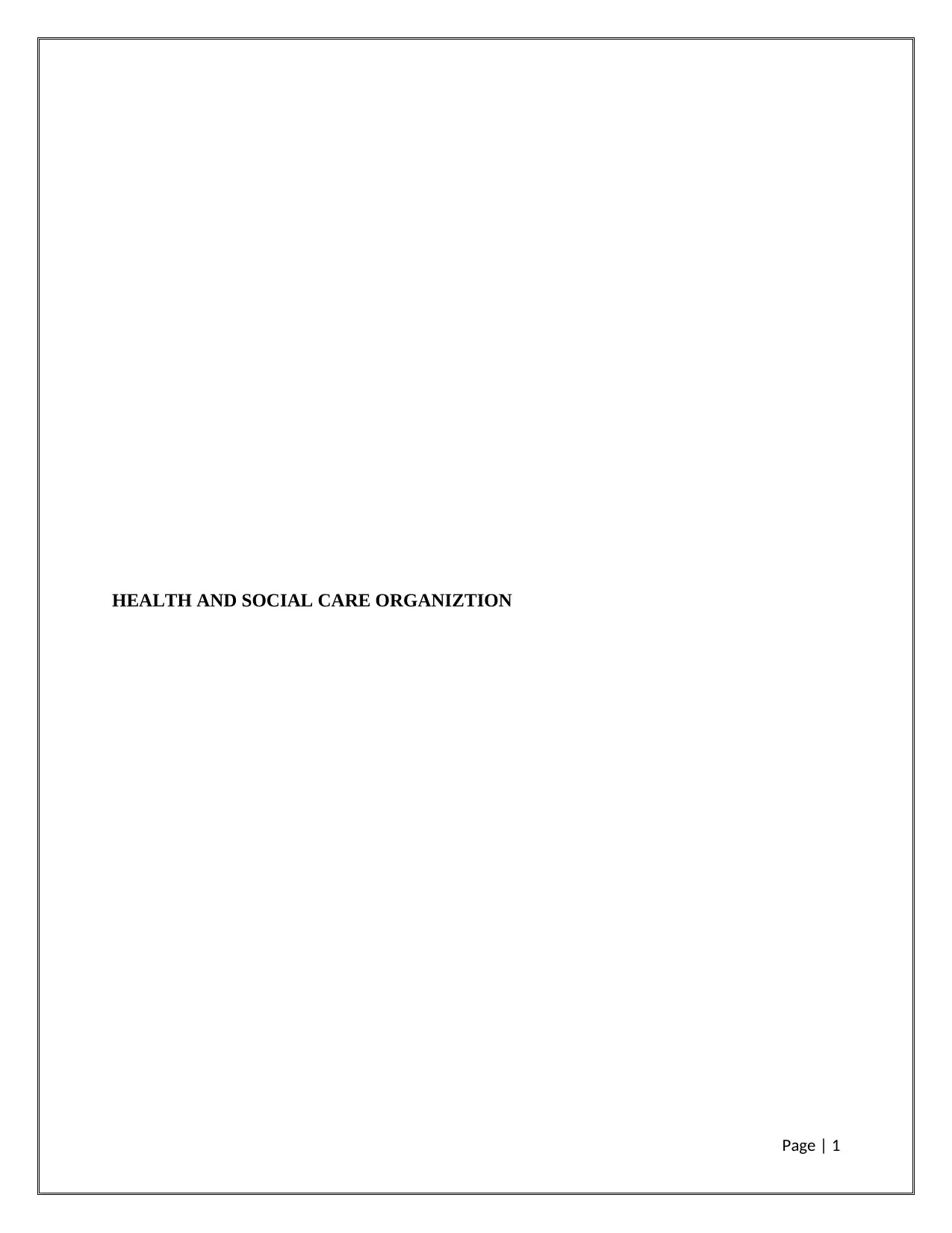
HEALTH AND SOCIAL CARE ORGANIZTION
Page | 1
Page | 1
Paraphrase This Document
Need a fresh take? Get an instant paraphrase of this document with our AI Paraphraser
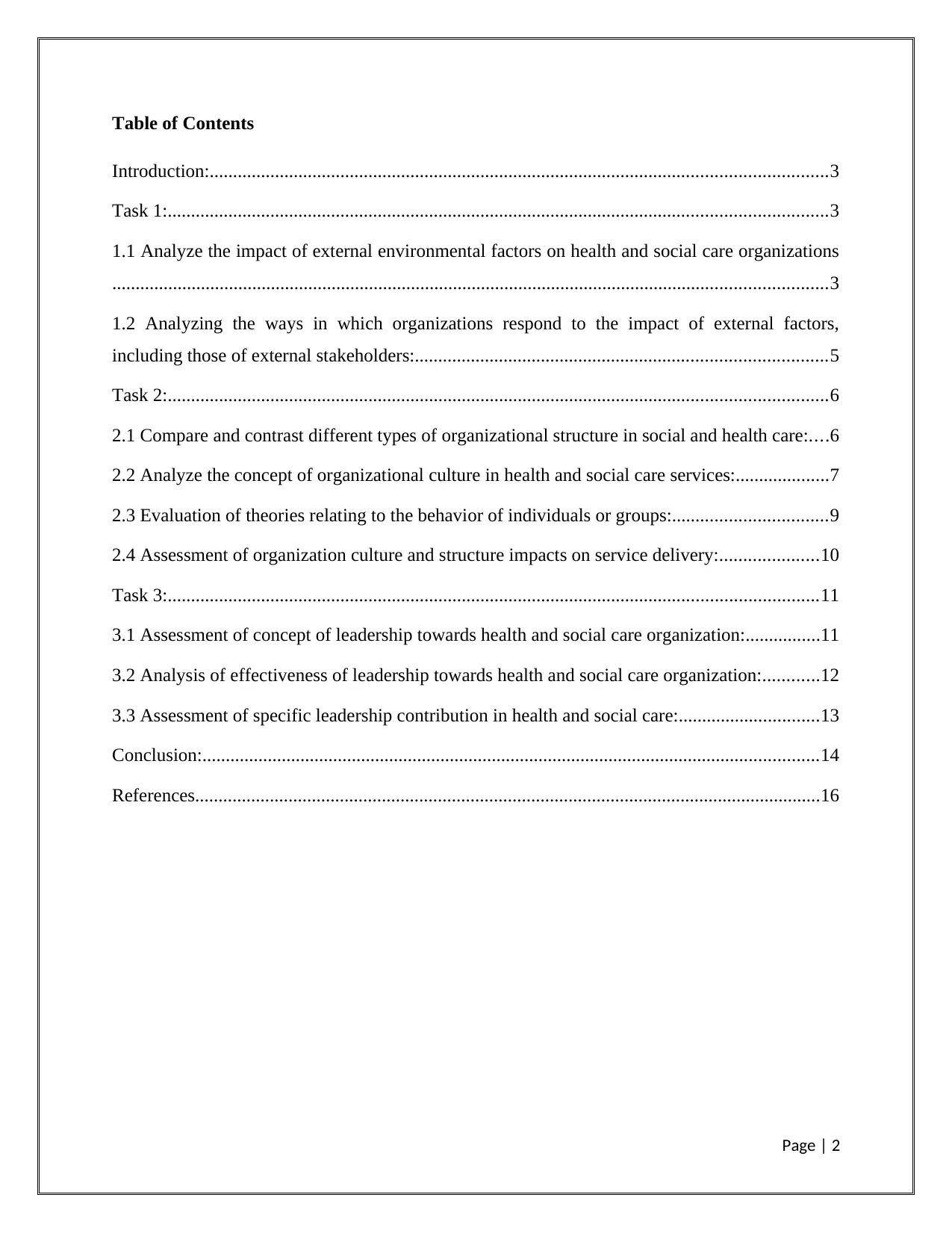
Table of Contents
Introduction:....................................................................................................................................3
Task 1:.............................................................................................................................................3
1.1 Analyze the impact of external environmental factors on health and social care organizations
.........................................................................................................................................................3
1.2 Analyzing the ways in which organizations respond to the impact of external factors,
including those of external stakeholders:........................................................................................5
Task 2:.............................................................................................................................................6
2.1 Compare and contrast different types of organizational structure in social and health care:....6
2.2 Analyze the concept of organizational culture in health and social care services:....................7
2.3 Evaluation of theories relating to the behavior of individuals or groups:.................................9
2.4 Assessment of organization culture and structure impacts on service delivery:.....................10
Task 3:...........................................................................................................................................11
3.1 Assessment of concept of leadership towards health and social care organization:................11
3.2 Analysis of effectiveness of leadership towards health and social care organization:............12
3.3 Assessment of specific leadership contribution in health and social care:..............................13
Conclusion:....................................................................................................................................14
References......................................................................................................................................16
Page | 2
Introduction:....................................................................................................................................3
Task 1:.............................................................................................................................................3
1.1 Analyze the impact of external environmental factors on health and social care organizations
.........................................................................................................................................................3
1.2 Analyzing the ways in which organizations respond to the impact of external factors,
including those of external stakeholders:........................................................................................5
Task 2:.............................................................................................................................................6
2.1 Compare and contrast different types of organizational structure in social and health care:....6
2.2 Analyze the concept of organizational culture in health and social care services:....................7
2.3 Evaluation of theories relating to the behavior of individuals or groups:.................................9
2.4 Assessment of organization culture and structure impacts on service delivery:.....................10
Task 3:...........................................................................................................................................11
3.1 Assessment of concept of leadership towards health and social care organization:................11
3.2 Analysis of effectiveness of leadership towards health and social care organization:............12
3.3 Assessment of specific leadership contribution in health and social care:..............................13
Conclusion:....................................................................................................................................14
References......................................................................................................................................16
Page | 2
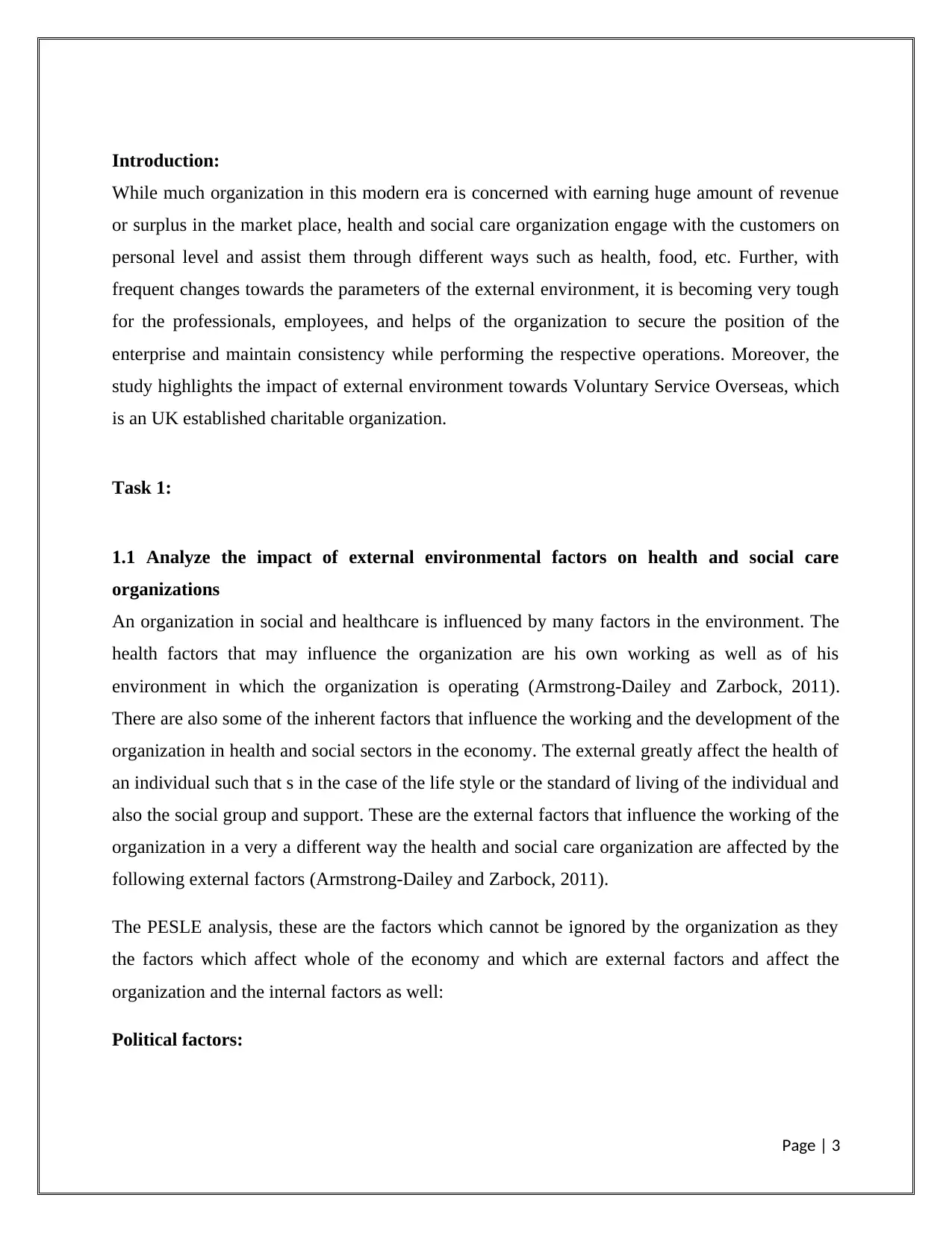
Introduction:
While much organization in this modern era is concerned with earning huge amount of revenue
or surplus in the market place, health and social care organization engage with the customers on
personal level and assist them through different ways such as health, food, etc. Further, with
frequent changes towards the parameters of the external environment, it is becoming very tough
for the professionals, employees, and helps of the organization to secure the position of the
enterprise and maintain consistency while performing the respective operations. Moreover, the
study highlights the impact of external environment towards Voluntary Service Overseas, which
is an UK established charitable organization.
Task 1:
1.1 Analyze the impact of external environmental factors on health and social care
organizations
An organization in social and healthcare is influenced by many factors in the environment. The
health factors that may influence the organization are his own working as well as of his
environment in which the organization is operating (Armstrong-Dailey and Zarbock, 2011).
There are also some of the inherent factors that influence the working and the development of the
organization in health and social sectors in the economy. The external greatly affect the health of
an individual such that s in the case of the life style or the standard of living of the individual and
also the social group and support. These are the external factors that influence the working of the
organization in a very a different way the health and social care organization are affected by the
following external factors (Armstrong-Dailey and Zarbock, 2011).
The PESLE analysis, these are the factors which cannot be ignored by the organization as they
the factors which affect whole of the economy and which are external factors and affect the
organization and the internal factors as well:
Political factors:
Page | 3
While much organization in this modern era is concerned with earning huge amount of revenue
or surplus in the market place, health and social care organization engage with the customers on
personal level and assist them through different ways such as health, food, etc. Further, with
frequent changes towards the parameters of the external environment, it is becoming very tough
for the professionals, employees, and helps of the organization to secure the position of the
enterprise and maintain consistency while performing the respective operations. Moreover, the
study highlights the impact of external environment towards Voluntary Service Overseas, which
is an UK established charitable organization.
Task 1:
1.1 Analyze the impact of external environmental factors on health and social care
organizations
An organization in social and healthcare is influenced by many factors in the environment. The
health factors that may influence the organization are his own working as well as of his
environment in which the organization is operating (Armstrong-Dailey and Zarbock, 2011).
There are also some of the inherent factors that influence the working and the development of the
organization in health and social sectors in the economy. The external greatly affect the health of
an individual such that s in the case of the life style or the standard of living of the individual and
also the social group and support. These are the external factors that influence the working of the
organization in a very a different way the health and social care organization are affected by the
following external factors (Armstrong-Dailey and Zarbock, 2011).
The PESLE analysis, these are the factors which cannot be ignored by the organization as they
the factors which affect whole of the economy and which are external factors and affect the
organization and the internal factors as well:
Political factors:
Page | 3
⊘ This is a preview!⊘
Do you want full access?
Subscribe today to unlock all pages.

Trusted by 1+ million students worldwide
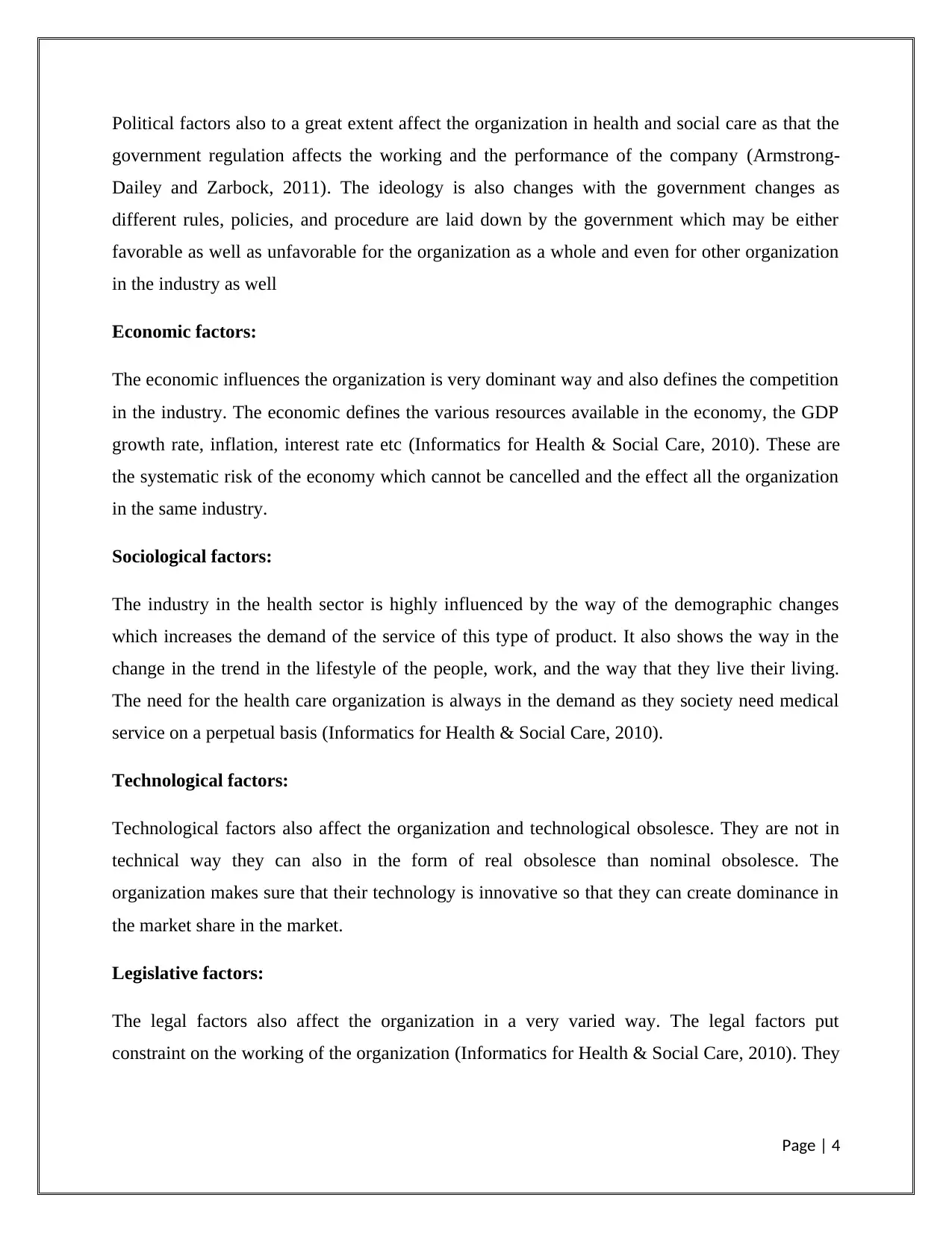
Political factors also to a great extent affect the organization in health and social care as that the
government regulation affects the working and the performance of the company (Armstrong-
Dailey and Zarbock, 2011). The ideology is also changes with the government changes as
different rules, policies, and procedure are laid down by the government which may be either
favorable as well as unfavorable for the organization as a whole and even for other organization
in the industry as well
Economic factors:
The economic influences the organization is very dominant way and also defines the competition
in the industry. The economic defines the various resources available in the economy, the GDP
growth rate, inflation, interest rate etc (Informatics for Health & Social Care, 2010). These are
the systematic risk of the economy which cannot be cancelled and the effect all the organization
in the same industry.
Sociological factors:
The industry in the health sector is highly influenced by the way of the demographic changes
which increases the demand of the service of this type of product. It also shows the way in the
change in the trend in the lifestyle of the people, work, and the way that they live their living.
The need for the health care organization is always in the demand as they society need medical
service on a perpetual basis (Informatics for Health & Social Care, 2010).
Technological factors:
Technological factors also affect the organization and technological obsolesce. They are not in
technical way they can also in the form of real obsolesce than nominal obsolesce. The
organization makes sure that their technology is innovative so that they can create dominance in
the market share in the market.
Legislative factors:
The legal factors also affect the organization in a very varied way. The legal factors put
constraint on the working of the organization (Informatics for Health & Social Care, 2010). They
Page | 4
government regulation affects the working and the performance of the company (Armstrong-
Dailey and Zarbock, 2011). The ideology is also changes with the government changes as
different rules, policies, and procedure are laid down by the government which may be either
favorable as well as unfavorable for the organization as a whole and even for other organization
in the industry as well
Economic factors:
The economic influences the organization is very dominant way and also defines the competition
in the industry. The economic defines the various resources available in the economy, the GDP
growth rate, inflation, interest rate etc (Informatics for Health & Social Care, 2010). These are
the systematic risk of the economy which cannot be cancelled and the effect all the organization
in the same industry.
Sociological factors:
The industry in the health sector is highly influenced by the way of the demographic changes
which increases the demand of the service of this type of product. It also shows the way in the
change in the trend in the lifestyle of the people, work, and the way that they live their living.
The need for the health care organization is always in the demand as they society need medical
service on a perpetual basis (Informatics for Health & Social Care, 2010).
Technological factors:
Technological factors also affect the organization and technological obsolesce. They are not in
technical way they can also in the form of real obsolesce than nominal obsolesce. The
organization makes sure that their technology is innovative so that they can create dominance in
the market share in the market.
Legislative factors:
The legal factors also affect the organization in a very varied way. The legal factors put
constraint on the working of the organization (Informatics for Health & Social Care, 2010). They
Page | 4
Paraphrase This Document
Need a fresh take? Get an instant paraphrase of this document with our AI Paraphraser
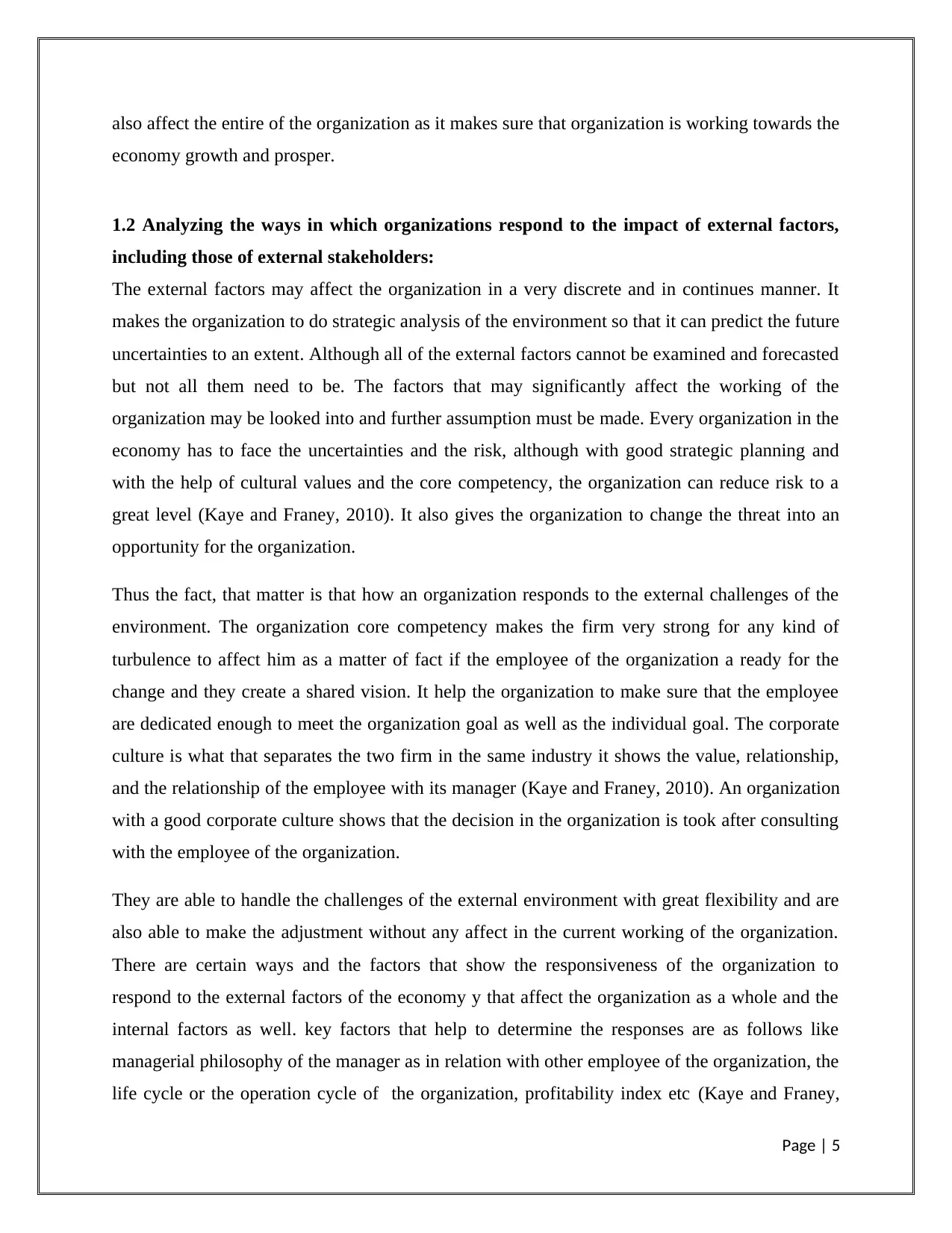
also affect the entire of the organization as it makes sure that organization is working towards the
economy growth and prosper.
1.2 Analyzing the ways in which organizations respond to the impact of external factors,
including those of external stakeholders:
The external factors may affect the organization in a very discrete and in continues manner. It
makes the organization to do strategic analysis of the environment so that it can predict the future
uncertainties to an extent. Although all of the external factors cannot be examined and forecasted
but not all them need to be. The factors that may significantly affect the working of the
organization may be looked into and further assumption must be made. Every organization in the
economy has to face the uncertainties and the risk, although with good strategic planning and
with the help of cultural values and the core competency, the organization can reduce risk to a
great level (Kaye and Franey, 2010). It also gives the organization to change the threat into an
opportunity for the organization.
Thus the fact, that matter is that how an organization responds to the external challenges of the
environment. The organization core competency makes the firm very strong for any kind of
turbulence to affect him as a matter of fact if the employee of the organization a ready for the
change and they create a shared vision. It help the organization to make sure that the employee
are dedicated enough to meet the organization goal as well as the individual goal. The corporate
culture is what that separates the two firm in the same industry it shows the value, relationship,
and the relationship of the employee with its manager (Kaye and Franey, 2010). An organization
with a good corporate culture shows that the decision in the organization is took after consulting
with the employee of the organization.
They are able to handle the challenges of the external environment with great flexibility and are
also able to make the adjustment without any affect in the current working of the organization.
There are certain ways and the factors that show the responsiveness of the organization to
respond to the external factors of the economy y that affect the organization as a whole and the
internal factors as well. key factors that help to determine the responses are as follows like
managerial philosophy of the manager as in relation with other employee of the organization, the
life cycle or the operation cycle of the organization, profitability index etc (Kaye and Franey,
Page | 5
economy growth and prosper.
1.2 Analyzing the ways in which organizations respond to the impact of external factors,
including those of external stakeholders:
The external factors may affect the organization in a very discrete and in continues manner. It
makes the organization to do strategic analysis of the environment so that it can predict the future
uncertainties to an extent. Although all of the external factors cannot be examined and forecasted
but not all them need to be. The factors that may significantly affect the working of the
organization may be looked into and further assumption must be made. Every organization in the
economy has to face the uncertainties and the risk, although with good strategic planning and
with the help of cultural values and the core competency, the organization can reduce risk to a
great level (Kaye and Franey, 2010). It also gives the organization to change the threat into an
opportunity for the organization.
Thus the fact, that matter is that how an organization responds to the external challenges of the
environment. The organization core competency makes the firm very strong for any kind of
turbulence to affect him as a matter of fact if the employee of the organization a ready for the
change and they create a shared vision. It help the organization to make sure that the employee
are dedicated enough to meet the organization goal as well as the individual goal. The corporate
culture is what that separates the two firm in the same industry it shows the value, relationship,
and the relationship of the employee with its manager (Kaye and Franey, 2010). An organization
with a good corporate culture shows that the decision in the organization is took after consulting
with the employee of the organization.
They are able to handle the challenges of the external environment with great flexibility and are
also able to make the adjustment without any affect in the current working of the organization.
There are certain ways and the factors that show the responsiveness of the organization to
respond to the external factors of the economy y that affect the organization as a whole and the
internal factors as well. key factors that help to determine the responses are as follows like
managerial philosophy of the manager as in relation with other employee of the organization, the
life cycle or the operation cycle of the organization, profitability index etc (Kaye and Franey,
Page | 5
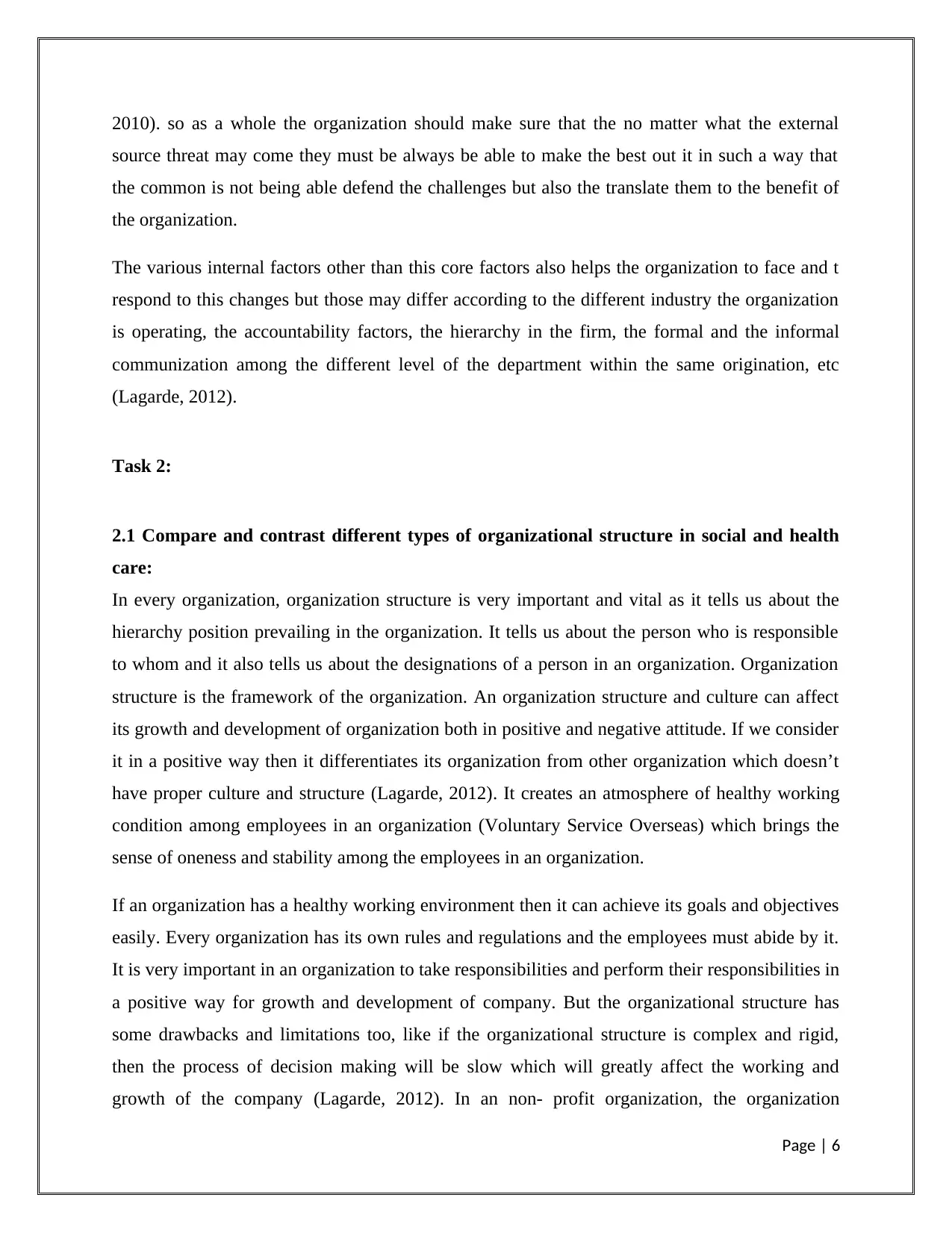
2010). so as a whole the organization should make sure that the no matter what the external
source threat may come they must be always be able to make the best out it in such a way that
the common is not being able defend the challenges but also the translate them to the benefit of
the organization.
The various internal factors other than this core factors also helps the organization to face and t
respond to this changes but those may differ according to the different industry the organization
is operating, the accountability factors, the hierarchy in the firm, the formal and the informal
communization among the different level of the department within the same origination, etc
(Lagarde, 2012).
Task 2:
2.1 Compare and contrast different types of organizational structure in social and health
care:
In every organization, organization structure is very important and vital as it tells us about the
hierarchy position prevailing in the organization. It tells us about the person who is responsible
to whom and it also tells us about the designations of a person in an organization. Organization
structure is the framework of the organization. An organization structure and culture can affect
its growth and development of organization both in positive and negative attitude. If we consider
it in a positive way then it differentiates its organization from other organization which doesn’t
have proper culture and structure (Lagarde, 2012). It creates an atmosphere of healthy working
condition among employees in an organization (Voluntary Service Overseas) which brings the
sense of oneness and stability among the employees in an organization.
If an organization has a healthy working environment then it can achieve its goals and objectives
easily. Every organization has its own rules and regulations and the employees must abide by it.
It is very important in an organization to take responsibilities and perform their responsibilities in
a positive way for growth and development of company. But the organizational structure has
some drawbacks and limitations too, like if the organizational structure is complex and rigid,
then the process of decision making will be slow which will greatly affect the working and
growth of the company (Lagarde, 2012). In an non- profit organization, the organization
Page | 6
source threat may come they must be always be able to make the best out it in such a way that
the common is not being able defend the challenges but also the translate them to the benefit of
the organization.
The various internal factors other than this core factors also helps the organization to face and t
respond to this changes but those may differ according to the different industry the organization
is operating, the accountability factors, the hierarchy in the firm, the formal and the informal
communization among the different level of the department within the same origination, etc
(Lagarde, 2012).
Task 2:
2.1 Compare and contrast different types of organizational structure in social and health
care:
In every organization, organization structure is very important and vital as it tells us about the
hierarchy position prevailing in the organization. It tells us about the person who is responsible
to whom and it also tells us about the designations of a person in an organization. Organization
structure is the framework of the organization. An organization structure and culture can affect
its growth and development of organization both in positive and negative attitude. If we consider
it in a positive way then it differentiates its organization from other organization which doesn’t
have proper culture and structure (Lagarde, 2012). It creates an atmosphere of healthy working
condition among employees in an organization (Voluntary Service Overseas) which brings the
sense of oneness and stability among the employees in an organization.
If an organization has a healthy working environment then it can achieve its goals and objectives
easily. Every organization has its own rules and regulations and the employees must abide by it.
It is very important in an organization to take responsibilities and perform their responsibilities in
a positive way for growth and development of company. But the organizational structure has
some drawbacks and limitations too, like if the organizational structure is complex and rigid,
then the process of decision making will be slow which will greatly affect the working and
growth of the company (Lagarde, 2012). In an non- profit organization, the organization
Page | 6
⊘ This is a preview!⊘
Do you want full access?
Subscribe today to unlock all pages.

Trusted by 1+ million students worldwide
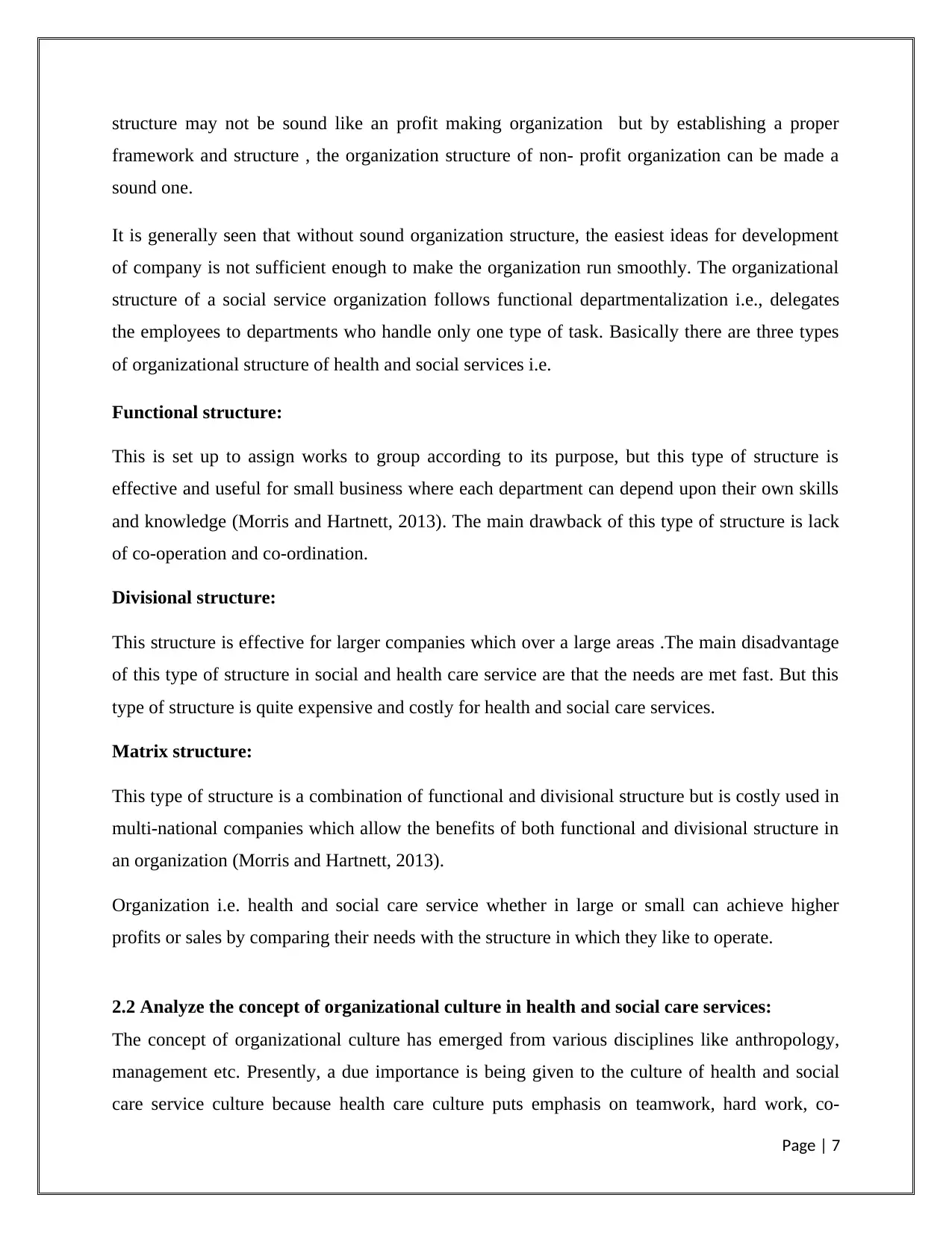
structure may not be sound like an profit making organization but by establishing a proper
framework and structure , the organization structure of non- profit organization can be made a
sound one.
It is generally seen that without sound organization structure, the easiest ideas for development
of company is not sufficient enough to make the organization run smoothly. The organizational
structure of a social service organization follows functional departmentalization i.e., delegates
the employees to departments who handle only one type of task. Basically there are three types
of organizational structure of health and social services i.e.
Functional structure:
This is set up to assign works to group according to its purpose, but this type of structure is
effective and useful for small business where each department can depend upon their own skills
and knowledge (Morris and Hartnett, 2013). The main drawback of this type of structure is lack
of co-operation and co-ordination.
Divisional structure:
This structure is effective for larger companies which over a large areas .The main disadvantage
of this type of structure in social and health care service are that the needs are met fast. But this
type of structure is quite expensive and costly for health and social care services.
Matrix structure:
This type of structure is a combination of functional and divisional structure but is costly used in
multi-national companies which allow the benefits of both functional and divisional structure in
an organization (Morris and Hartnett, 2013).
Organization i.e. health and social care service whether in large or small can achieve higher
profits or sales by comparing their needs with the structure in which they like to operate.
2.2 Analyze the concept of organizational culture in health and social care services:
The concept of organizational culture has emerged from various disciplines like anthropology,
management etc. Presently, a due importance is being given to the culture of health and social
care service culture because health care culture puts emphasis on teamwork, hard work, co-
Page | 7
framework and structure , the organization structure of non- profit organization can be made a
sound one.
It is generally seen that without sound organization structure, the easiest ideas for development
of company is not sufficient enough to make the organization run smoothly. The organizational
structure of a social service organization follows functional departmentalization i.e., delegates
the employees to departments who handle only one type of task. Basically there are three types
of organizational structure of health and social services i.e.
Functional structure:
This is set up to assign works to group according to its purpose, but this type of structure is
effective and useful for small business where each department can depend upon their own skills
and knowledge (Morris and Hartnett, 2013). The main drawback of this type of structure is lack
of co-operation and co-ordination.
Divisional structure:
This structure is effective for larger companies which over a large areas .The main disadvantage
of this type of structure in social and health care service are that the needs are met fast. But this
type of structure is quite expensive and costly for health and social care services.
Matrix structure:
This type of structure is a combination of functional and divisional structure but is costly used in
multi-national companies which allow the benefits of both functional and divisional structure in
an organization (Morris and Hartnett, 2013).
Organization i.e. health and social care service whether in large or small can achieve higher
profits or sales by comparing their needs with the structure in which they like to operate.
2.2 Analyze the concept of organizational culture in health and social care services:
The concept of organizational culture has emerged from various disciplines like anthropology,
management etc. Presently, a due importance is being given to the culture of health and social
care service culture because health care culture puts emphasis on teamwork, hard work, co-
Page | 7
Paraphrase This Document
Need a fresh take? Get an instant paraphrase of this document with our AI Paraphraser
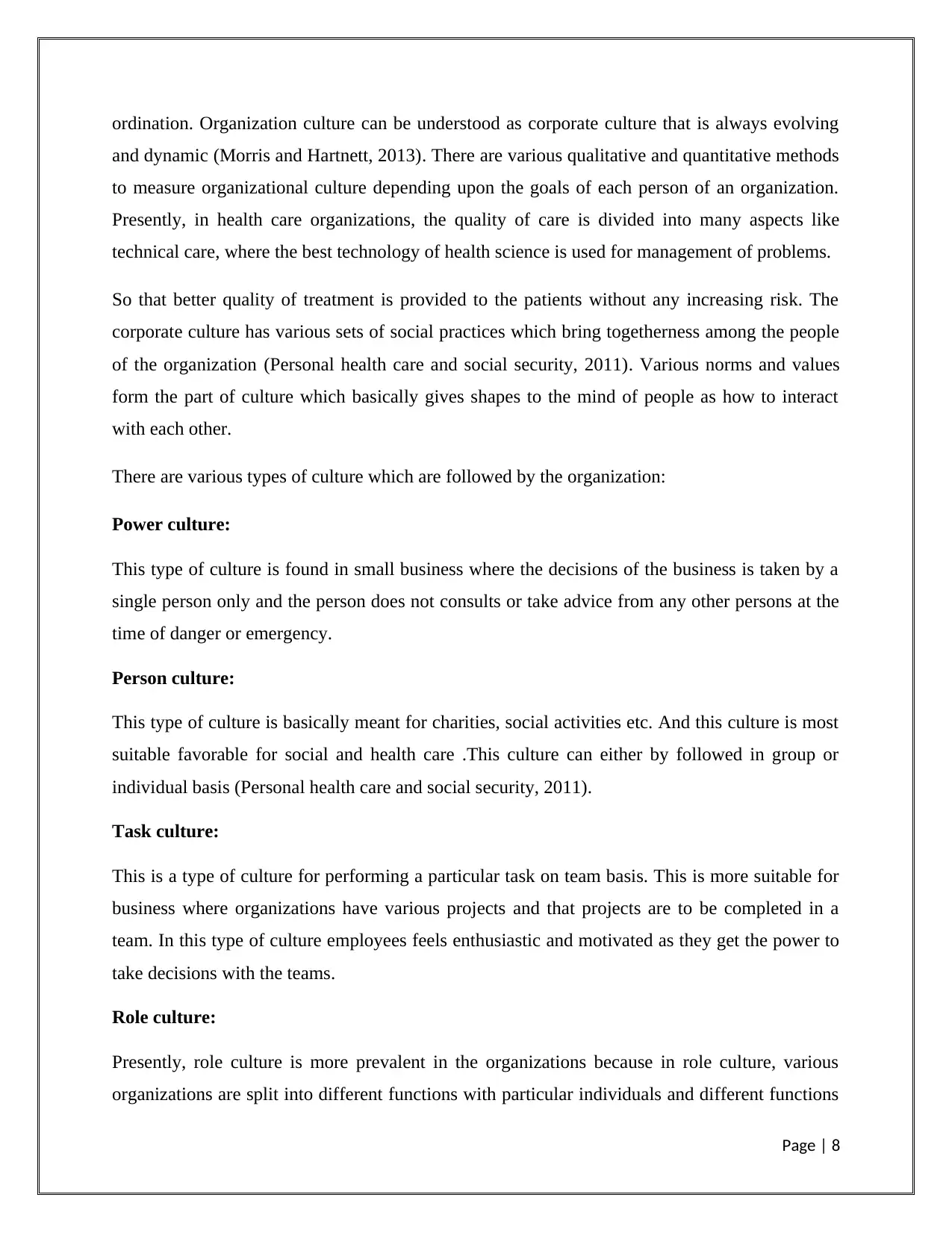
ordination. Organization culture can be understood as corporate culture that is always evolving
and dynamic (Morris and Hartnett, 2013). There are various qualitative and quantitative methods
to measure organizational culture depending upon the goals of each person of an organization.
Presently, in health care organizations, the quality of care is divided into many aspects like
technical care, where the best technology of health science is used for management of problems.
So that better quality of treatment is provided to the patients without any increasing risk. The
corporate culture has various sets of social practices which bring togetherness among the people
of the organization (Personal health care and social security, 2011). Various norms and values
form the part of culture which basically gives shapes to the mind of people as how to interact
with each other.
There are various types of culture which are followed by the organization:
Power culture:
This type of culture is found in small business where the decisions of the business is taken by a
single person only and the person does not consults or take advice from any other persons at the
time of danger or emergency.
Person culture:
This type of culture is basically meant for charities, social activities etc. And this culture is most
suitable favorable for social and health care .This culture can either by followed in group or
individual basis (Personal health care and social security, 2011).
Task culture:
This is a type of culture for performing a particular task on team basis. This is more suitable for
business where organizations have various projects and that projects are to be completed in a
team. In this type of culture employees feels enthusiastic and motivated as they get the power to
take decisions with the teams.
Role culture:
Presently, role culture is more prevalent in the organizations because in role culture, various
organizations are split into different functions with particular individuals and different functions
Page | 8
and dynamic (Morris and Hartnett, 2013). There are various qualitative and quantitative methods
to measure organizational culture depending upon the goals of each person of an organization.
Presently, in health care organizations, the quality of care is divided into many aspects like
technical care, where the best technology of health science is used for management of problems.
So that better quality of treatment is provided to the patients without any increasing risk. The
corporate culture has various sets of social practices which bring togetherness among the people
of the organization (Personal health care and social security, 2011). Various norms and values
form the part of culture which basically gives shapes to the mind of people as how to interact
with each other.
There are various types of culture which are followed by the organization:
Power culture:
This type of culture is found in small business where the decisions of the business is taken by a
single person only and the person does not consults or take advice from any other persons at the
time of danger or emergency.
Person culture:
This type of culture is basically meant for charities, social activities etc. And this culture is most
suitable favorable for social and health care .This culture can either by followed in group or
individual basis (Personal health care and social security, 2011).
Task culture:
This is a type of culture for performing a particular task on team basis. This is more suitable for
business where organizations have various projects and that projects are to be completed in a
team. In this type of culture employees feels enthusiastic and motivated as they get the power to
take decisions with the teams.
Role culture:
Presently, role culture is more prevalent in the organizations because in role culture, various
organizations are split into different functions with particular individuals and different functions
Page | 8
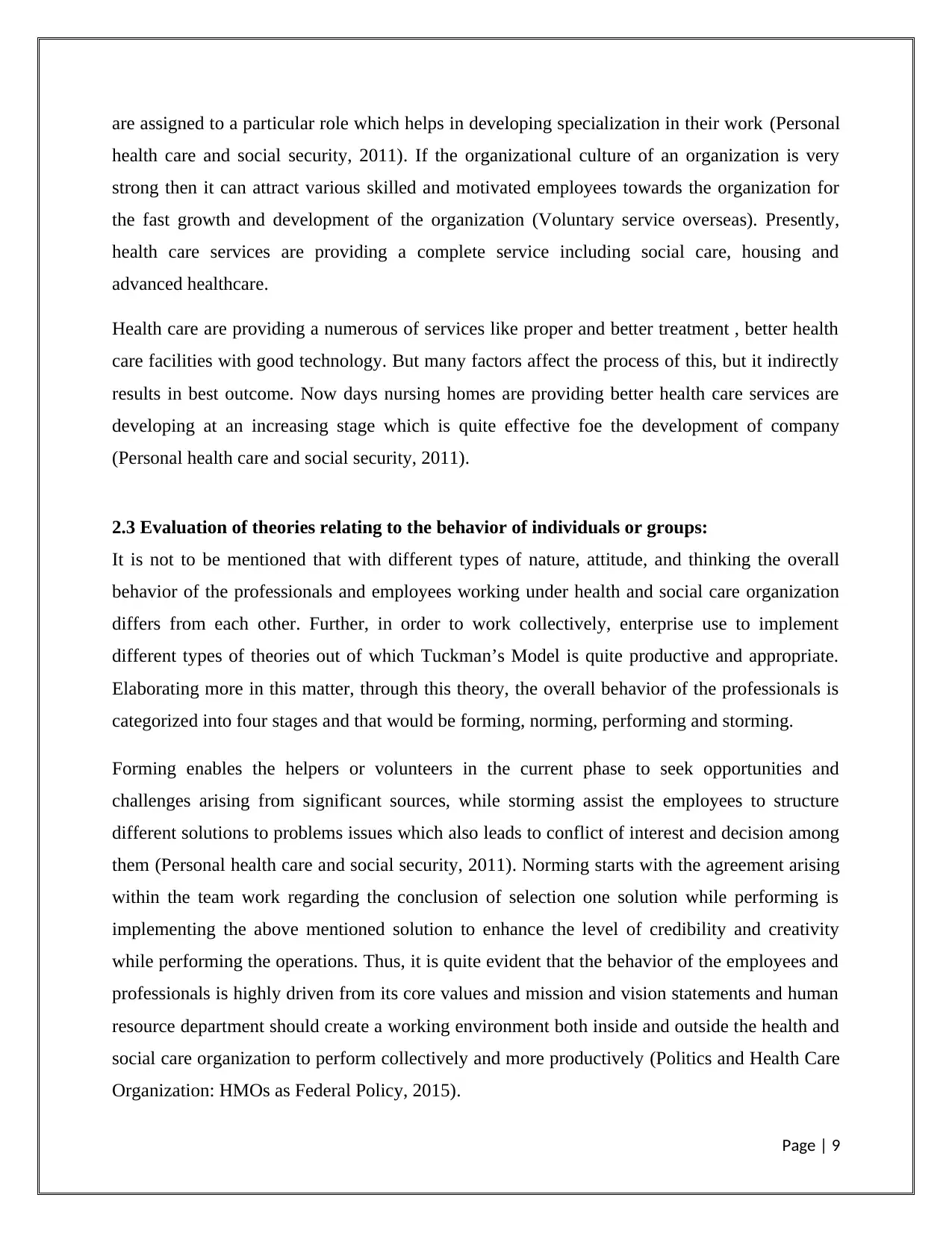
are assigned to a particular role which helps in developing specialization in their work (Personal
health care and social security, 2011). If the organizational culture of an organization is very
strong then it can attract various skilled and motivated employees towards the organization for
the fast growth and development of the organization (Voluntary service overseas). Presently,
health care services are providing a complete service including social care, housing and
advanced healthcare.
Health care are providing a numerous of services like proper and better treatment , better health
care facilities with good technology. But many factors affect the process of this, but it indirectly
results in best outcome. Now days nursing homes are providing better health care services are
developing at an increasing stage which is quite effective foe the development of company
(Personal health care and social security, 2011).
2.3 Evaluation of theories relating to the behavior of individuals or groups:
It is not to be mentioned that with different types of nature, attitude, and thinking the overall
behavior of the professionals and employees working under health and social care organization
differs from each other. Further, in order to work collectively, enterprise use to implement
different types of theories out of which Tuckman’s Model is quite productive and appropriate.
Elaborating more in this matter, through this theory, the overall behavior of the professionals is
categorized into four stages and that would be forming, norming, performing and storming.
Forming enables the helpers or volunteers in the current phase to seek opportunities and
challenges arising from significant sources, while storming assist the employees to structure
different solutions to problems issues which also leads to conflict of interest and decision among
them (Personal health care and social security, 2011). Norming starts with the agreement arising
within the team work regarding the conclusion of selection one solution while performing is
implementing the above mentioned solution to enhance the level of credibility and creativity
while performing the operations. Thus, it is quite evident that the behavior of the employees and
professionals is highly driven from its core values and mission and vision statements and human
resource department should create a working environment both inside and outside the health and
social care organization to perform collectively and more productively (Politics and Health Care
Organization: HMOs as Federal Policy, 2015).
Page | 9
health care and social security, 2011). If the organizational culture of an organization is very
strong then it can attract various skilled and motivated employees towards the organization for
the fast growth and development of the organization (Voluntary service overseas). Presently,
health care services are providing a complete service including social care, housing and
advanced healthcare.
Health care are providing a numerous of services like proper and better treatment , better health
care facilities with good technology. But many factors affect the process of this, but it indirectly
results in best outcome. Now days nursing homes are providing better health care services are
developing at an increasing stage which is quite effective foe the development of company
(Personal health care and social security, 2011).
2.3 Evaluation of theories relating to the behavior of individuals or groups:
It is not to be mentioned that with different types of nature, attitude, and thinking the overall
behavior of the professionals and employees working under health and social care organization
differs from each other. Further, in order to work collectively, enterprise use to implement
different types of theories out of which Tuckman’s Model is quite productive and appropriate.
Elaborating more in this matter, through this theory, the overall behavior of the professionals is
categorized into four stages and that would be forming, norming, performing and storming.
Forming enables the helpers or volunteers in the current phase to seek opportunities and
challenges arising from significant sources, while storming assist the employees to structure
different solutions to problems issues which also leads to conflict of interest and decision among
them (Personal health care and social security, 2011). Norming starts with the agreement arising
within the team work regarding the conclusion of selection one solution while performing is
implementing the above mentioned solution to enhance the level of credibility and creativity
while performing the operations. Thus, it is quite evident that the behavior of the employees and
professionals is highly driven from its core values and mission and vision statements and human
resource department should create a working environment both inside and outside the health and
social care organization to perform collectively and more productively (Politics and Health Care
Organization: HMOs as Federal Policy, 2015).
Page | 9
⊘ This is a preview!⊘
Do you want full access?
Subscribe today to unlock all pages.

Trusted by 1+ million students worldwide
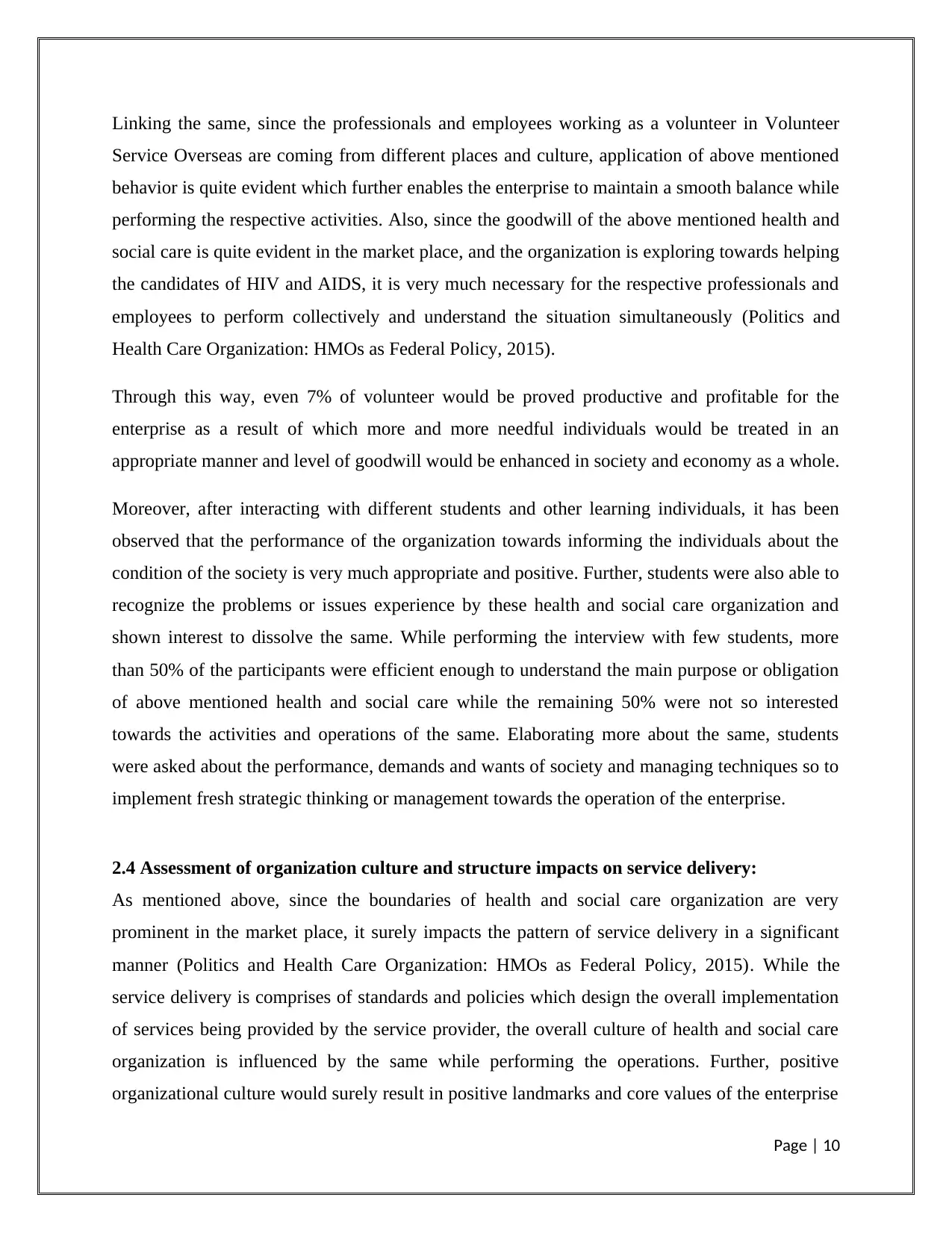
Linking the same, since the professionals and employees working as a volunteer in Volunteer
Service Overseas are coming from different places and culture, application of above mentioned
behavior is quite evident which further enables the enterprise to maintain a smooth balance while
performing the respective activities. Also, since the goodwill of the above mentioned health and
social care is quite evident in the market place, and the organization is exploring towards helping
the candidates of HIV and AIDS, it is very much necessary for the respective professionals and
employees to perform collectively and understand the situation simultaneously (Politics and
Health Care Organization: HMOs as Federal Policy, 2015).
Through this way, even 7% of volunteer would be proved productive and profitable for the
enterprise as a result of which more and more needful individuals would be treated in an
appropriate manner and level of goodwill would be enhanced in society and economy as a whole.
Moreover, after interacting with different students and other learning individuals, it has been
observed that the performance of the organization towards informing the individuals about the
condition of the society is very much appropriate and positive. Further, students were also able to
recognize the problems or issues experience by these health and social care organization and
shown interest to dissolve the same. While performing the interview with few students, more
than 50% of the participants were efficient enough to understand the main purpose or obligation
of above mentioned health and social care while the remaining 50% were not so interested
towards the activities and operations of the same. Elaborating more about the same, students
were asked about the performance, demands and wants of society and managing techniques so to
implement fresh strategic thinking or management towards the operation of the enterprise.
2.4 Assessment of organization culture and structure impacts on service delivery:
As mentioned above, since the boundaries of health and social care organization are very
prominent in the market place, it surely impacts the pattern of service delivery in a significant
manner (Politics and Health Care Organization: HMOs as Federal Policy, 2015). While the
service delivery is comprises of standards and policies which design the overall implementation
of services being provided by the service provider, the overall culture of health and social care
organization is influenced by the same while performing the operations. Further, positive
organizational culture would surely result in positive landmarks and core values of the enterprise
Page | 10
Service Overseas are coming from different places and culture, application of above mentioned
behavior is quite evident which further enables the enterprise to maintain a smooth balance while
performing the respective activities. Also, since the goodwill of the above mentioned health and
social care is quite evident in the market place, and the organization is exploring towards helping
the candidates of HIV and AIDS, it is very much necessary for the respective professionals and
employees to perform collectively and understand the situation simultaneously (Politics and
Health Care Organization: HMOs as Federal Policy, 2015).
Through this way, even 7% of volunteer would be proved productive and profitable for the
enterprise as a result of which more and more needful individuals would be treated in an
appropriate manner and level of goodwill would be enhanced in society and economy as a whole.
Moreover, after interacting with different students and other learning individuals, it has been
observed that the performance of the organization towards informing the individuals about the
condition of the society is very much appropriate and positive. Further, students were also able to
recognize the problems or issues experience by these health and social care organization and
shown interest to dissolve the same. While performing the interview with few students, more
than 50% of the participants were efficient enough to understand the main purpose or obligation
of above mentioned health and social care while the remaining 50% were not so interested
towards the activities and operations of the same. Elaborating more about the same, students
were asked about the performance, demands and wants of society and managing techniques so to
implement fresh strategic thinking or management towards the operation of the enterprise.
2.4 Assessment of organization culture and structure impacts on service delivery:
As mentioned above, since the boundaries of health and social care organization are very
prominent in the market place, it surely impacts the pattern of service delivery in a significant
manner (Politics and Health Care Organization: HMOs as Federal Policy, 2015). While the
service delivery is comprises of standards and policies which design the overall implementation
of services being provided by the service provider, the overall culture of health and social care
organization is influenced by the same while performing the operations. Further, positive
organizational culture would surely result in positive landmarks and core values of the enterprise
Page | 10
Paraphrase This Document
Need a fresh take? Get an instant paraphrase of this document with our AI Paraphraser
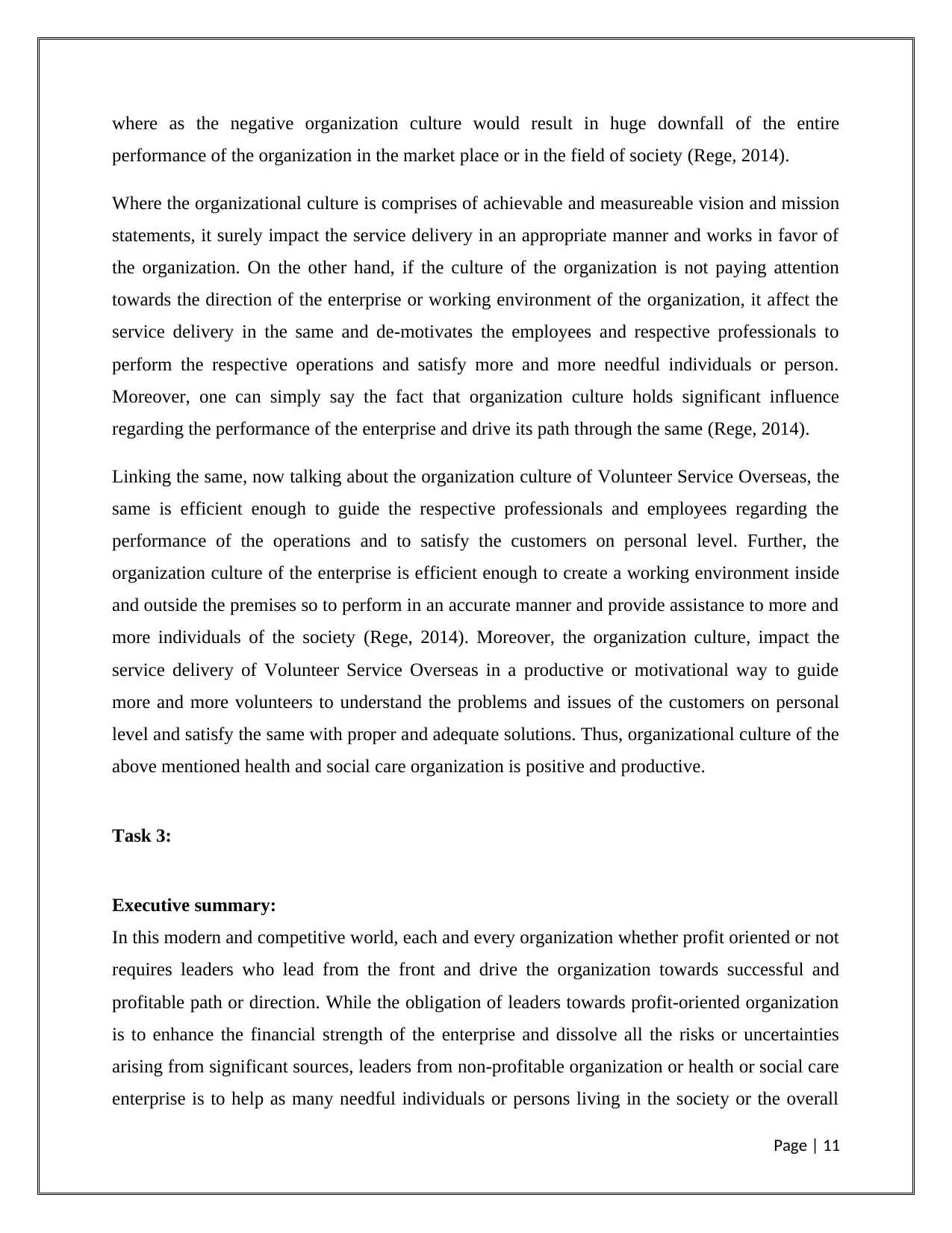
where as the negative organization culture would result in huge downfall of the entire
performance of the organization in the market place or in the field of society (Rege, 2014).
Where the organizational culture is comprises of achievable and measureable vision and mission
statements, it surely impact the service delivery in an appropriate manner and works in favor of
the organization. On the other hand, if the culture of the organization is not paying attention
towards the direction of the enterprise or working environment of the organization, it affect the
service delivery in the same and de-motivates the employees and respective professionals to
perform the respective operations and satisfy more and more needful individuals or person.
Moreover, one can simply say the fact that organization culture holds significant influence
regarding the performance of the enterprise and drive its path through the same (Rege, 2014).
Linking the same, now talking about the organization culture of Volunteer Service Overseas, the
same is efficient enough to guide the respective professionals and employees regarding the
performance of the operations and to satisfy the customers on personal level. Further, the
organization culture of the enterprise is efficient enough to create a working environment inside
and outside the premises so to perform in an accurate manner and provide assistance to more and
more individuals of the society (Rege, 2014). Moreover, the organization culture, impact the
service delivery of Volunteer Service Overseas in a productive or motivational way to guide
more and more volunteers to understand the problems and issues of the customers on personal
level and satisfy the same with proper and adequate solutions. Thus, organizational culture of the
above mentioned health and social care organization is positive and productive.
Task 3:
Executive summary:
In this modern and competitive world, each and every organization whether profit oriented or not
requires leaders who lead from the front and drive the organization towards successful and
profitable path or direction. While the obligation of leaders towards profit-oriented organization
is to enhance the financial strength of the enterprise and dissolve all the risks or uncertainties
arising from significant sources, leaders from non-profitable organization or health or social care
enterprise is to help as many needful individuals or persons living in the society or the overall
Page | 11
performance of the organization in the market place or in the field of society (Rege, 2014).
Where the organizational culture is comprises of achievable and measureable vision and mission
statements, it surely impact the service delivery in an appropriate manner and works in favor of
the organization. On the other hand, if the culture of the organization is not paying attention
towards the direction of the enterprise or working environment of the organization, it affect the
service delivery in the same and de-motivates the employees and respective professionals to
perform the respective operations and satisfy more and more needful individuals or person.
Moreover, one can simply say the fact that organization culture holds significant influence
regarding the performance of the enterprise and drive its path through the same (Rege, 2014).
Linking the same, now talking about the organization culture of Volunteer Service Overseas, the
same is efficient enough to guide the respective professionals and employees regarding the
performance of the operations and to satisfy the customers on personal level. Further, the
organization culture of the enterprise is efficient enough to create a working environment inside
and outside the premises so to perform in an accurate manner and provide assistance to more and
more individuals of the society (Rege, 2014). Moreover, the organization culture, impact the
service delivery of Volunteer Service Overseas in a productive or motivational way to guide
more and more volunteers to understand the problems and issues of the customers on personal
level and satisfy the same with proper and adequate solutions. Thus, organizational culture of the
above mentioned health and social care organization is positive and productive.
Task 3:
Executive summary:
In this modern and competitive world, each and every organization whether profit oriented or not
requires leaders who lead from the front and drive the organization towards successful and
profitable path or direction. While the obligation of leaders towards profit-oriented organization
is to enhance the financial strength of the enterprise and dissolve all the risks or uncertainties
arising from significant sources, leaders from non-profitable organization or health or social care
enterprise is to help as many needful individuals or persons living in the society or the overall
Page | 11

economy. Considering the operations of health and social care organization and the respective
relevance of social activities, leaders who understand the overall objective of the enterprise and
align each action with the same would be the most profitable one as it enhances the overall
performance and position of the enterprise in the overall economy and minds of the people.
Further, by implementing the above mentioned leadership, the overall condition and status of
that of society would also enhance which further would put direct impact towards the economic
condition of the country as a whole. Elaborating more about the same, leaders who are able to
satisfy more and more needful ones with minimal effort and activities are required to exist in the
market place for longer period of time and enhance the overall position and that of performance
in the market place. Also, leaders who provides equivalent amount of attention and focus
towards dissolving the risks or uncertainties arising from significant sources and enhance the
level of customer satisfaction towards productive level or standard.
Leaders do not only enhance the overall performance of the enterprise, but also create a bond
among employees within the premises to increase the smoothness of working environment and
culture and fulfill the respective obligations in an appropriate manner. Leaders enable the
employees to take pride of their respective job and feel satisfied and proud by helping millions of
customers on regular basis. Further, by giving the organization a purposeful direction, leaders
enables the respective professionals to align each action with that of objectives, vision, and
mission of the enterprise so to enhance the level of uniqueness and overall strength of the
enterprise in the market place.
Moreover, the study emphasis the importance of considering democratic leadership over and
above autocratic in this modern era, to create productive bond with the individuals of the society
and contribute collectively towards enhancing the overall condition of the economy. Through
democratic leadership, both job satisfaction and customer’s satisfaction would enhance which
further put positive impact towards the performance and position of the enterprise in the market
place.
3.1 Assessment of concept of leadership towards health and social care organization:
While the leaders of the profit oriented organization is focused towards enhancing the revenue
and overall surplus of the organization, leaders under health and social care is concerned with
Page | 12
relevance of social activities, leaders who understand the overall objective of the enterprise and
align each action with the same would be the most profitable one as it enhances the overall
performance and position of the enterprise in the overall economy and minds of the people.
Further, by implementing the above mentioned leadership, the overall condition and status of
that of society would also enhance which further would put direct impact towards the economic
condition of the country as a whole. Elaborating more about the same, leaders who are able to
satisfy more and more needful ones with minimal effort and activities are required to exist in the
market place for longer period of time and enhance the overall position and that of performance
in the market place. Also, leaders who provides equivalent amount of attention and focus
towards dissolving the risks or uncertainties arising from significant sources and enhance the
level of customer satisfaction towards productive level or standard.
Leaders do not only enhance the overall performance of the enterprise, but also create a bond
among employees within the premises to increase the smoothness of working environment and
culture and fulfill the respective obligations in an appropriate manner. Leaders enable the
employees to take pride of their respective job and feel satisfied and proud by helping millions of
customers on regular basis. Further, by giving the organization a purposeful direction, leaders
enables the respective professionals to align each action with that of objectives, vision, and
mission of the enterprise so to enhance the level of uniqueness and overall strength of the
enterprise in the market place.
Moreover, the study emphasis the importance of considering democratic leadership over and
above autocratic in this modern era, to create productive bond with the individuals of the society
and contribute collectively towards enhancing the overall condition of the economy. Through
democratic leadership, both job satisfaction and customer’s satisfaction would enhance which
further put positive impact towards the performance and position of the enterprise in the market
place.
3.1 Assessment of concept of leadership towards health and social care organization:
While the leaders of the profit oriented organization is focused towards enhancing the revenue
and overall surplus of the organization, leaders under health and social care is concerned with
Page | 12
⊘ This is a preview!⊘
Do you want full access?
Subscribe today to unlock all pages.

Trusted by 1+ million students worldwide
1 out of 18
Related Documents
Your All-in-One AI-Powered Toolkit for Academic Success.
+13062052269
info@desklib.com
Available 24*7 on WhatsApp / Email
![[object Object]](/_next/static/media/star-bottom.7253800d.svg)
Unlock your academic potential
Copyright © 2020–2025 A2Z Services. All Rights Reserved. Developed and managed by ZUCOL.





